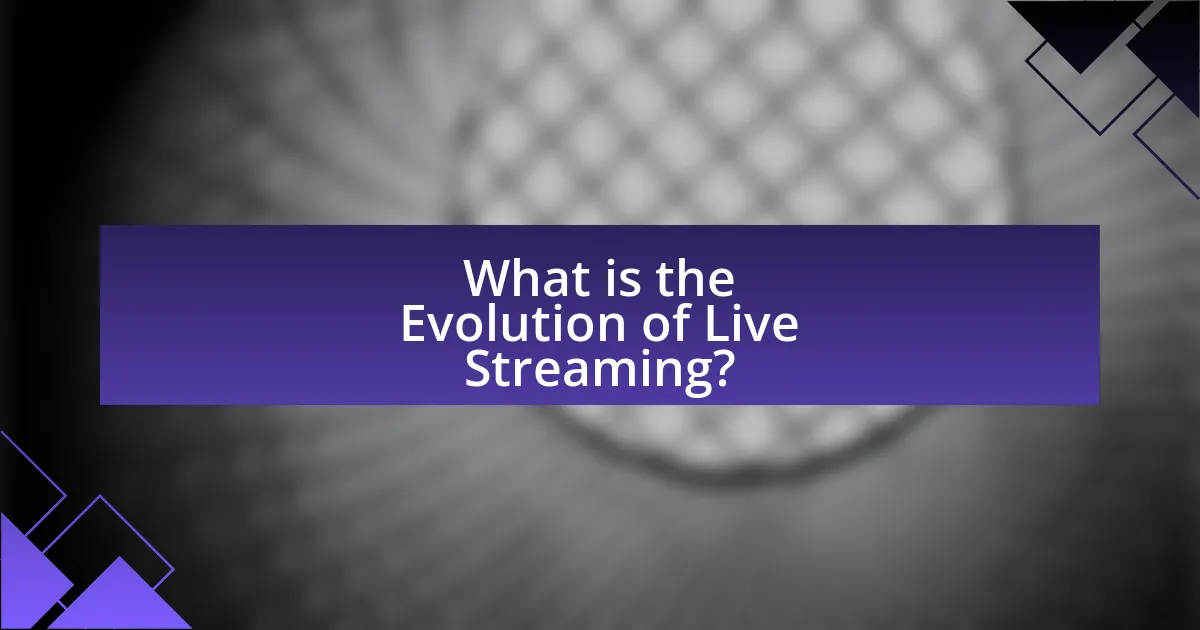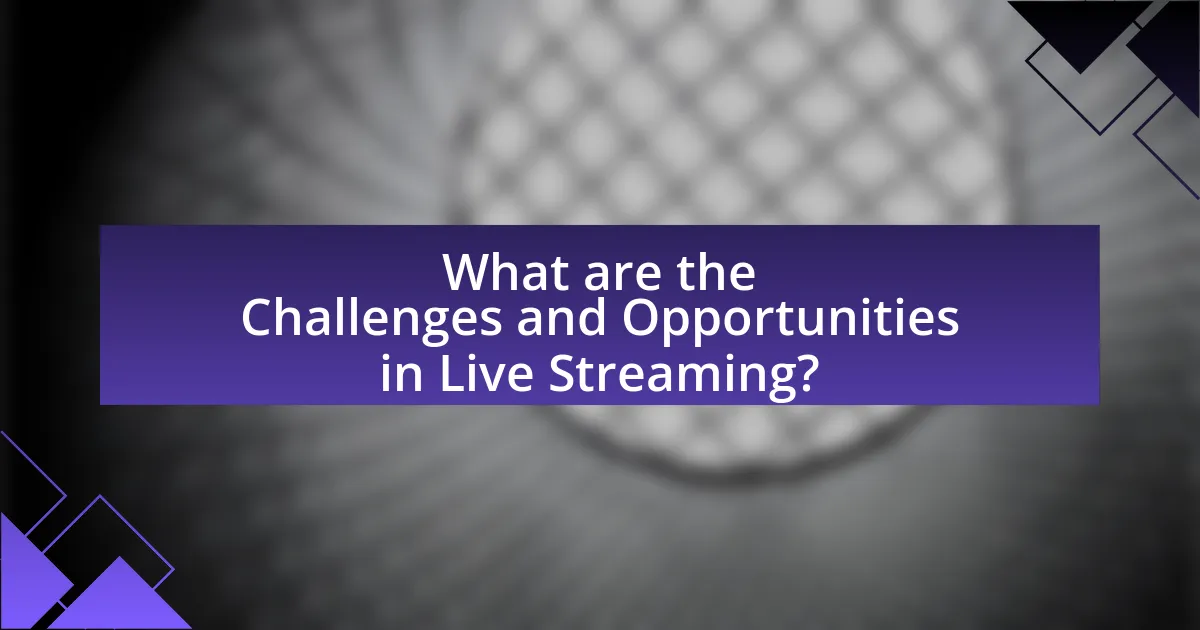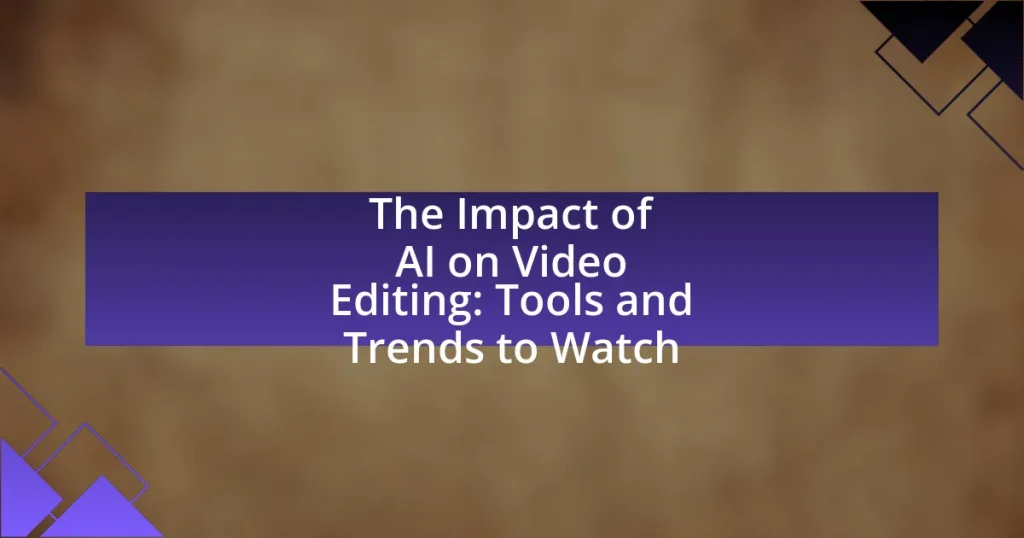The article focuses on the evolution of live streaming, tracing its development from the late 1990s to its current status as a mainstream medium in 2023. It highlights key technological advancements, such as improved internet bandwidth and mobile technology, that have transformed live streaming into an interactive and engaging experience for users. The article also examines how user preferences have shaped the evolution of live streaming, emphasizing the importance of real-time engagement and personalized content. Additionally, it discusses the challenges and opportunities for content creators and brands, as well as best practices for successful live streaming in 2024, including the integration of interactive features and the impact of mobile technology.

What is the Evolution of Live Streaming?
The evolution of live streaming began in the late 1990s with the introduction of technologies like RealPlayer, which allowed users to stream audio and video content over the internet. This initial phase was characterized by limited bandwidth and low-quality streams. In the early 2000s, platforms such as YouTube and Ustream emerged, enabling users to upload and share videos, which laid the groundwork for live streaming capabilities. By the 2010s, advancements in internet speeds and mobile technology led to the rise of platforms like Twitch and Facebook Live, which popularized real-time interaction and engagement. As of 2023, live streaming has become a mainstream medium, with significant growth in user engagement, driven by social media integration and the demand for authentic content. According to a report by Statista, the global live streaming market is projected to reach $247 billion by 2027, highlighting its rapid evolution and increasing importance in digital communication.
How has live streaming changed over the years?
Live streaming has evolved significantly over the years, transitioning from basic webcam broadcasts to high-definition, interactive experiences across multiple platforms. Initially, live streaming was limited to niche audiences and required substantial technical knowledge, but advancements in technology have democratized access, allowing anyone with an internet connection to broadcast. For instance, platforms like Twitch and YouTube Live have introduced user-friendly interfaces and monetization options, leading to a surge in content creators and viewers. According to a report by Statista, the global live streaming market is projected to reach $247 billion by 2027, highlighting its growing importance in entertainment and marketing. This evolution reflects not only technological advancements but also changing consumer behaviors, with audiences increasingly favoring real-time engagement and authentic interactions.
What technological advancements have influenced live streaming?
Technological advancements that have influenced live streaming include improved internet bandwidth, enhanced video compression technologies, and the proliferation of mobile devices. High-speed internet, such as 5G, allows for seamless streaming with minimal latency, enabling higher quality broadcasts. Advanced video codecs like H.264 and H.265 significantly reduce file sizes while maintaining video quality, making streaming more efficient. Additionally, the widespread use of smartphones and tablets has democratized content creation, allowing more users to stream live events easily. These advancements collectively enhance user experience and accessibility in live streaming.
How have user preferences shaped the evolution of live streaming?
User preferences have significantly shaped the evolution of live streaming by driving platforms to prioritize interactivity and personalization. As viewers increasingly seek engaging experiences, platforms like Twitch and YouTube Live have integrated features such as real-time chat, polls, and viewer participation tools, enhancing user engagement. According to a 2022 report by StreamElements, 70% of users prefer streams that allow for direct interaction with the streamer, indicating a clear demand for community involvement. This shift has led to the development of more user-centric features, such as customizable notifications and tailored content recommendations, further aligning live streaming with user desires for a more immersive and personalized viewing experience.
Why is live streaming important in today’s digital landscape?
Live streaming is important in today’s digital landscape because it fosters real-time engagement and interaction between content creators and audiences. This immediacy enhances user experience, as viewers can participate in discussions, ask questions, and provide feedback during broadcasts. According to a report by Statista, live streaming is projected to reach a market size of $247 billion by 2027, indicating its growing significance in digital communication. Furthermore, platforms like Twitch and YouTube Live have demonstrated that live content can drive higher viewer retention rates, with live streams generating up to 10 times more engagement than pre-recorded videos. This trend underscores the necessity for brands and creators to incorporate live streaming into their strategies to effectively connect with their audiences.
What role does live streaming play in content consumption?
Live streaming plays a crucial role in content consumption by providing real-time interaction and engagement between creators and audiences. This format allows viewers to participate actively through comments and reactions, fostering a sense of community and immediacy that pre-recorded content lacks. According to a report by Statista, live streaming is projected to reach a global market size of $184.3 billion by 2027, indicating its growing significance in the digital landscape. Additionally, platforms like Twitch and YouTube Live have demonstrated that live content can drive higher viewer retention and engagement rates compared to traditional video formats, further solidifying its importance in modern content consumption.
How does live streaming enhance audience engagement?
Live streaming enhances audience engagement by providing real-time interaction and immersive experiences. This immediacy allows viewers to participate actively through comments, questions, and reactions, fostering a sense of community. According to a study by Livestream and New York Magazine, 80% of audiences prefer live video over traditional social posts, indicating a strong preference for the interactive nature of live content. Additionally, platforms like Twitch and YouTube Live report higher viewer retention rates during live streams compared to pre-recorded videos, further demonstrating that live streaming effectively captures and maintains audience attention.

What are the Key Trends Driving Engagement in 2024?
Key trends driving engagement in 2024 include the rise of interactive content, personalized experiences, and the integration of augmented reality (AR) in live streaming. Interactive content, such as polls and Q&A sessions, fosters real-time audience participation, enhancing viewer connection. Personalized experiences leverage data analytics to tailor content to individual preferences, increasing viewer retention. The integration of AR enriches the visual experience, making live streams more immersive and engaging. According to a report by Statista, 63% of marketers believe that interactive content is effective in engaging audiences, highlighting its significance in driving engagement in the upcoming year.
How are social media platforms integrating live streaming?
Social media platforms are integrating live streaming by incorporating features that enhance user interaction and engagement. For instance, platforms like Facebook and Instagram allow users to broadcast live video to their followers, enabling real-time comments and reactions, which fosters a sense of community. Additionally, TikTok has introduced live streaming capabilities that include interactive elements such as virtual gifts and audience participation through polls. According to a report by Statista, the global live streaming market is projected to reach $247 billion by 2027, highlighting the growing importance of this feature in social media strategies.
What features are being introduced to enhance user interaction?
New features being introduced to enhance user interaction in live streaming include real-time polls, interactive Q&A sessions, and augmented reality (AR) overlays. These features allow viewers to engage actively during broadcasts, fostering a more immersive experience. For instance, real-time polls enable instant feedback from the audience, while interactive Q&A sessions facilitate direct communication between streamers and viewers. Additionally, AR overlays can create visually engaging content that captures viewer attention, as evidenced by platforms like Twitch and YouTube implementing these tools to boost engagement metrics significantly.
How do algorithms affect live streaming visibility?
Algorithms significantly influence live streaming visibility by determining which streams are promoted to users based on engagement metrics and viewer preferences. These algorithms analyze data such as viewer interactions, watch time, and content relevance to prioritize streams that are likely to attract more viewers. For instance, platforms like YouTube and Twitch utilize algorithms that favor streams with higher engagement rates, leading to increased visibility for those broadcasts. Research indicates that streams appearing on the front page or in recommended sections can see a viewership increase of up to 70%, demonstrating the direct impact of algorithmic decisions on visibility.
What impact does mobile technology have on live streaming?
Mobile technology significantly enhances live streaming by enabling real-time broadcasting from virtually anywhere. This capability allows content creators to engage with audiences instantly, fostering interactive experiences through features like live chats and instant feedback. According to a report by Statista, mobile devices accounted for over 60% of all video views in 2023, illustrating the dominance of mobile technology in the live streaming landscape. Furthermore, advancements in mobile internet speeds, such as the rollout of 5G, have improved streaming quality and reduced latency, making live broadcasts more accessible and enjoyable for viewers.
How are mobile devices changing the way audiences engage with live content?
Mobile devices are transforming audience engagement with live content by enabling real-time interaction and accessibility. This shift allows viewers to participate in live events through features like live chats, polls, and social media sharing, enhancing their overall experience. According to a 2023 report by Statista, 75% of live stream viewers engage with content via mobile devices, highlighting the importance of mobile accessibility in driving viewer participation. Additionally, mobile devices facilitate instant feedback and community building, as audiences can share their thoughts and reactions immediately, fostering a more interactive environment.
What are the implications of 5G technology for live streaming quality?
5G technology significantly enhances live streaming quality by providing faster data transfer speeds, lower latency, and increased network capacity. With speeds reaching up to 10 Gbps, 5G allows for high-definition and even 4K streaming without buffering, which is crucial for real-time content delivery. Additionally, the reduced latency of around 1 millisecond compared to 4G’s 30-50 milliseconds ensures that live interactions, such as gaming or virtual events, occur seamlessly. Furthermore, 5G’s ability to support a larger number of connected devices simultaneously means that more users can stream high-quality content without degradation in performance, making it ideal for large-scale events. These advancements are backed by industry reports indicating that 5G networks can handle up to 1 million devices per square kilometer, significantly improving the overall live streaming experience.

What are the Challenges and Opportunities in Live Streaming?
The challenges in live streaming include technical issues, such as latency and bandwidth limitations, which can disrupt viewer experience. Additionally, content moderation and copyright compliance pose significant hurdles, as platforms must navigate complex legal frameworks to avoid penalties. Opportunities in live streaming arise from the growing demand for interactive content and the ability to reach global audiences in real-time, which can enhance brand engagement and customer loyalty. According to a report by Statista, the global live streaming market is projected to reach $247 billion by 2027, indicating substantial growth potential for businesses that effectively leverage these opportunities.
What challenges do content creators face in live streaming?
Content creators face several challenges in live streaming, including technical issues, audience engagement, and content moderation. Technical issues such as poor internet connectivity can disrupt streams, leading to viewer frustration and loss of audience. Engaging an audience in real-time requires creators to be dynamic and responsive, which can be difficult, especially with large viewer numbers. Additionally, content moderation is crucial to maintain a positive environment, as creators must manage inappropriate comments and behavior, which can detract from the streaming experience. These challenges are supported by a 2023 report from Streamlabs, which highlights that 30% of streamers cite technical difficulties as a primary concern, while 25% struggle with audience interaction.
How can creators overcome technical difficulties during live streams?
Creators can overcome technical difficulties during live streams by implementing a robust pre-stream checklist and utilizing reliable streaming software. A pre-stream checklist ensures that all equipment, including cameras, microphones, and internet connections, are functioning properly before going live. Reliable streaming software, such as OBS Studio or Streamlabs, provides features that help manage potential issues, like buffering or audio problems, in real-time. According to a survey by Streamlabs, 70% of streamers reported that using dedicated software significantly reduced their technical issues during broadcasts.
What strategies can be employed to maintain viewer engagement?
To maintain viewer engagement, interactive elements such as live polls, Q&A sessions, and real-time feedback mechanisms can be employed. These strategies encourage active participation, making viewers feel involved and valued. Research indicates that streams incorporating interactive features see a 30% increase in viewer retention compared to traditional formats. Additionally, personalized content tailored to viewer preferences enhances engagement, as 70% of audiences are more likely to stay tuned when content aligns with their interests.
What opportunities exist for brands in live streaming?
Brands have significant opportunities in live streaming, including real-time engagement, direct sales, and enhanced brand visibility. Real-time engagement allows brands to interact with audiences instantly, fostering a sense of community and loyalty. For instance, platforms like Twitch and Instagram Live have shown that brands can increase customer interaction by up to 80% during live events. Direct sales opportunities arise through features like shoppable live streams, where viewers can purchase products directly while watching, leading to higher conversion rates; studies indicate that live shopping can boost sales by 30% compared to traditional e-commerce. Enhanced brand visibility is achieved through collaborations with influencers and content creators, which can expand reach and attract new audiences; research shows that 70% of consumers trust influencer recommendations, making this a powerful strategy for brand growth.
How can brands leverage live streaming for marketing purposes?
Brands can leverage live streaming for marketing purposes by engaging audiences in real-time, creating interactive experiences that enhance customer connection. This approach allows brands to showcase products, host Q&A sessions, and provide behind-the-scenes content, fostering a sense of community and immediacy. According to a report by Livestream and New York Magazine, 80% of consumers prefer to watch live videos from brands rather than read blog posts, highlighting the effectiveness of live streaming in capturing audience attention and driving engagement.
What are the best practices for brands to engage with audiences during live streams?
Brands should prioritize interactivity, authenticity, and value delivery to effectively engage with audiences during live streams. Interactivity can be achieved through real-time polls, Q&A sessions, and encouraging comments, which fosters a sense of community and involvement. Authenticity is crucial; brands should showcase genuine personalities and behind-the-scenes content to build trust and relatability. Delivering value, such as exclusive offers or informative content, keeps viewers interested and encourages them to stay engaged throughout the stream. According to a study by Livestream and New York Magazine, 80% of consumers prefer live video from brands over traditional social posts, highlighting the effectiveness of these engagement strategies.
What are the Best Practices for Successful Live Streaming in 2024?
The best practices for successful live streaming in 2024 include ensuring high-quality video and audio, engaging with the audience in real-time, and promoting the stream across multiple platforms. High-quality video and audio are critical as they directly impact viewer retention; studies show that 80% of viewers will abandon a stream if the quality is poor. Engaging with the audience through live chats or polls fosters a sense of community and increases viewer interaction, which is essential for maintaining interest. Additionally, promoting the stream on social media and other channels before and during the event can significantly increase viewership, as 54% of audiences discover live streams through social media platforms.
How can content creators prepare for a successful live stream?
Content creators can prepare for a successful live stream by ensuring they have a reliable internet connection, high-quality audio and video equipment, and a well-structured content plan. A stable internet connection is crucial, as disruptions can lead to viewer drop-off; studies show that 47% of viewers abandon a stream due to buffering issues. High-quality audio and video enhance viewer experience, with 85% of viewers indicating that sound quality is more important than video quality. Additionally, a structured content plan helps maintain engagement, as 70% of successful streams follow a clear outline or script.
What tools and technologies are essential for effective live streaming?
Essential tools and technologies for effective live streaming include high-quality cameras, reliable microphones, streaming software, and a stable internet connection. High-quality cameras, such as DSLRs or mirrorless models, provide superior video clarity, while reliable microphones ensure clear audio, which is crucial for viewer engagement. Streaming software, like OBS Studio or Streamlabs, allows for seamless broadcasting and integration of graphics and overlays. A stable internet connection, ideally with upload speeds of at least 5 Mbps, is necessary to prevent buffering and maintain stream quality. These components collectively enhance the viewer experience and contribute to successful live streaming.



